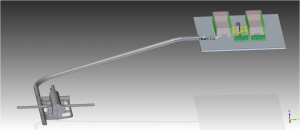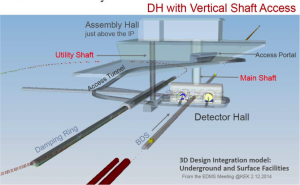After the release of the Technical Design Report (TDR) in June 2013, the ILC project entered a new phase, in which the community awaits a (hopefully positive) decision for the project in Japan. As soon as the preferred location was announced, work began to adapt the accelerator to the building site in the Kitakami area. The TDR baseline design of the ILC has to undergo many adjustments and updates before the machine would reach the building phase. More detailed specification and technical drawings, further R&D and changes due to the specifics of the preferred project site were necessary. So one question arose: How best to handle all of these changes? How to document them, and what kind of communication and reviewing would be needed?
At this point a new tool was implemented for the ILC: Change Management. It started life as a tool to classify and structure the new inputs, but it has developed into an important driving force of the project.
“At the beginning the idea was really just to give everyone a tool to better communicate and track all the changes which need to be done. But it has become a real modus operandi for the project, ” says Benno List, physicist at DESY, who takes care of all the formal change requests for the ILC and by doing this helps to push the project forward. List is the Change Administrator of the ILC Change Management Board, which consists of the ILC’s nine Technical Board (TB) members, a civil engineering expert, and two designated representatives of the physics and detector community.
Change Management in general is a frequently used tool in industry to formalise the documentation process and to systematically handle changes during an ongoing project. This includes every step from the identification of the need for a change to the finished implementation and installation of the new design, procedures, or tools. “When we first installed this for ILC, people were skeptical, but it really evolved and it is now broadly accepted as the way of doing things for the project,” says List. “It helps a lot. The project has many participants in various institutes in different countries and the constant flow of information about further changes and developments guides the way for everyone.”

In the original TDR design, it was foreseen to access the underground experimental hall via an inclined horizontal tunnel.
In the report ‘Change Management for the ILC’ List and his colleagues explain the formalised process for change requests to the ILC baseline. The report clarifies the four main steps which are needed. The first step is the creation of the change request and its submission. The change request should be a document which specifies the requested change and its influence on the machine. The report should also include further important information like cost estimations and other details which will be needed to fully review the influence of the change. The second step is the evaluation of the change request. The CMB and – if needed – a group of experts review the requested change. “The review by the Change Review Panel can be a small project in itself. A central part of the whole process is communication. Everyone in the community should feel informed and take part in the activities. Changes are not made silently but always publicly announced including the recommendation of the experts and the CMB.” To be able to handle this List uses the ILC’s Engineering Data Management System (EDMS) which contains the baseline status of the ILC including technical drawings, specifications and R&D information on different aspects of the project. Broader discussions can take place in various forms of meetings at workshops and conferences. At these meetings anyone can state his or her opinion about the planned change.
The third step would be the decision making. Here a decision based on the discussion and recommendation of the experts is taken. This is documented including all reasons for this decision. Of course, the decision will also be publicly announced over the mailing lists. The final step is updating the ILC baseline to reflect the changes that have been made. To prevent continuous updating of the same sections in the baseline report, items which are affected by several change requests will be updated to reflect all change requests that have been accepted already. The resulting design is documented in the EDMS, where it is available for the whole community.

The change request was submitted by the MDI group to provide a vertical access shaft for the ILC experimental hall as well, so that the detectors could be assembled mainly above ground.
“We update the baseline constantly to prevent frustration. Nothing is more frustrating for the community than if time and effort is spent on something that is already made obsolete by another design change,” he says. This also helps to structure the ILC communities’ resources more effectively and brings the whole project forward. While one change request is processed, a waiting list with possible further changes is maintained. The CMB has its eyes on the various activities within the community and is in constant communication with the working groups so that a priority list concerning the required R&D, further specific changes and upcoming future changes can be developed as the projects evolves.
“The influence of the different change requests varies greatly. Some requests handle one specific part where other requests collect a few more changes and details together. One request even shifted the whole accelerator tunnel and the experimental hall by 800 metres from its original planned position, while another one just added a 10-centimetre long beam position monitor to the detectors,” recounts List. Since the baseline report of the ILC varies strongly in the level of detail, complexity and documentation within the different sections of the machine design, the CMB also handles changes in all their various stages of complexity and detail.
Most of the changes at this stage are introduced to fit the machine design into the possible site in Japan. So the changes influence the general setup, like the decision to move the cryogenic plants for the accelerator onto the surface, instead of keeping them underground in the tunnels as stated in the baseline. Others change the location of the whole accelerator tunnel within the landscape due to geographic properties, or add an extra shaft which enters vertically into the experimental halls to make the assembly of the detectors easier. Smaller changes deal with details concerning magnets and technical drawings which have needed updates due to further improve the function of those specific parts. More information about the already made changes on the ILC baseline will be soon available in LC Newsline.
There is one class of changes which is not handled by the CMB in this fashion: all changes regarding the highest level technical parameters such as energy and luminosity. Those changes are escalated to Linear Collider Collaboration (LCC) directorate and the Linear Collider Board (LCB) as required. The process is still documented with the help of the CMB.
“Right now, we have roughly one new change request per month coming up. Reviewing and implementing them gives us a working plan to move the project forward.”, says List about the amount of changes. The ILC community has embraced the idea of change management readily and is now using it as a way to structure its activities, and to bring together new solutions and ideas for the machine. This development is better than expected.
“It has really become a driving force of the project. This is remarkable,” concludes List about the impact of the CMB for the ILC.

Recent Comments